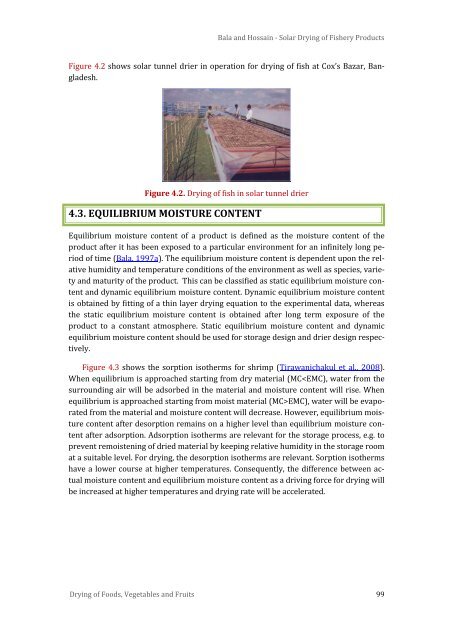Solar Drying: Fundamentals,Applications and Innovations - National ...
Solar Drying: Fundamentals,Applications and Innovations - National ...
Solar Drying: Fundamentals,Applications and Innovations - National ...
You also want an ePaper? Increase the reach of your titles
YUMPU automatically turns print PDFs into web optimized ePapers that Google loves.
Bala <strong>and</strong> Hossain - <strong>Solar</strong> <strong>Drying</strong> of Fishery Products<br />
Figure 4.2 shows solar tunnel drier in operation for drying of fish at Cox’s Bazar, Bangladesh.<br />
Figure 4.2. <strong>Drying</strong> of fish in solar tunnel drier<br />
4.3. EQUILIBRIUM MOISTURE CONTENT<br />
Equilibrium moisture content of a product is defined as the moisture content of the<br />
product after it has been exposed to a particular environment for an infinitely long period<br />
of time (Bala, 1997a). The equilibrium moisture content is dependent upon the relative<br />
humidity <strong>and</strong> temperature conditions of the environment as well as species, variety<br />
<strong>and</strong> maturity of the product. This can be classified as static equilibrium moisture content<br />
<strong>and</strong> dynamic equilibrium moisture content. Dynamic equilibrium moisture content<br />
is obtained by fitting of a thin layer drying equation to the experimental data, whereas<br />
the static equilibrium moisture content is obtained after long term exposure of the<br />
product to a constant atmosphere. Static equilibrium moisture content <strong>and</strong> dynamic<br />
equilibrium moisture content should be used for storage design <strong>and</strong> drier design respectively.<br />
Figure 4.3 shows the sorption isotherms for shrimp (Tirawanichakul et al., 2008).<br />
When equilibrium is approached starting from dry material (MCEMC), water will be evaporated<br />
from the material <strong>and</strong> moisture content will decrease. However, equilibrium moisture<br />
content after desorption remains on a higher level than equilibrium moisture content<br />
after adsorption. Adsorption isotherms are relevant for the storage process, e.g. to<br />
prevent remoistening of dried material by keeping relative humidity in the storage room<br />
at a suitable level. For drying, the desorption isotherms are relevant. Sorption isotherms<br />
have a lower course at higher temperatures. Consequently, the difference between actual<br />
moisture content <strong>and</strong> equilibrium moisture content as a driving force for drying will<br />
be increased at higher temperatures <strong>and</strong> drying rate will be accelerated.<br />
<strong>Drying</strong> of Foods, Vegetables <strong>and</strong> Fruits 99

















